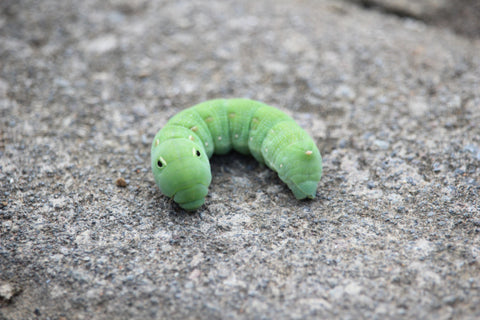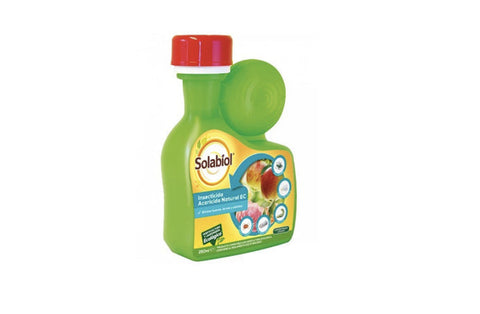Best price on the market

How to prevent and eliminate the bud caterpillar
The bud caterpillar, a term that immediately evokes concern in any cannabis grower, refers to the larvae of several species of moths that feed on the plant's prized flowers. These caterpillars not only cleverly hide among the buds, but also cause significant damage by feeding on them, compromising the quality and yield of the crop.
In the world of marijuana, the presence of these pests can be particularly devastating. Not only do they break down the internal structure of the buds, leaving them susceptible to fungal and bacterial diseases, but they can also ruin the aesthetic appearance and potency of the flower. Therefore, effectively identifying and controlling these caterpillars is a critical aspect for any grower, whether hobby or commercial.
Since the goal is often to obtain the highest quality production, especially when cannabis is grown for medicinal or high-end purposes, knowing how to kill caterpillars and prevent their appearance is essential.
Preventing caterpillar infestation on buds involves maintaining proper hygiene and using preventive techniques such as nets or traps. To eliminate them, you can apply organic pesticides such as bacillus thuringiensis or resort to manual methods by carefully removing them.

How to Identify the Bud Caterpillar
The bud caterpillar, a silent enemy in cannabis cultivation, is the larva of various species of moths. These larvae vary in color, from green to brown, allowing them to effectively camouflage themselves among the leaves and flowers of the plant. Its life cycle begins when the adult moth lays eggs on marijuana plants. Once hatched, the tiny worms begin feeding voraciously on the leaves and, more crucially, the buds of the plant.
Over time, these caterpillars grow, going through several larval stages before turning into chrysalises and finally adult moths, ready to continue the cycle. This cycle can vary in duration depending on environmental conditions, being faster in hot and humid climates.
Signs of Infestation
Identifying a bud caterpillar infestation on marijuana plants can be challenging due to their camouflage ability. However, there are several indicative signs:
- Physical Damage : Buds may show signs of damage, such as chewed areas or gaps. Small perforations can also be found on the leaves.
- Caterpillar Droppings : Small black or green dots, known as caterpillar droppings, may appear on leaves and around buds.
- Presence of Silk : Caterpillars often leave a fine silk network on the buds and leaves, similar to spider webs.
- Bud Decay : Buds that turn brown and decay prematurely can be a sign of serious infestation, often accompanied by mold or mildew due to internal damage and trapped moisture.
How to prevent the appearance of the bud caterpillar
Prevention is key in the management of the bud caterpillar in cannabis crops. Implementing proper growing practices and environmental and physical control methods can make all the difference in keeping these pests at bay.
Cultivation Practices to Prevent the Appearance of the Marijuana Caterpillar
- Selection of Resistant Varieties : Some cannabis varieties are more resistant to pests. Opting for these varieties can reduce the likelihood of infestations.
- Crop Rotation : Alternate plants in your growing space. This can prevent the buildup of cannabis-specific pests and diseases.
- Maintaining Hygiene in the Growing Area : Keeping the area clean and free of plant debris can reduce the places where moths can lay their eggs.
- Regular Monitoring : Inspecting plants regularly for early signs of infestation can allow for early intervention before the situation worsens.
Environmental and Physical Control Methods
- Physical Barriers : Using fine mesh or crop covers can prevent moths from laying eggs on plants.
- Lighting Control : Ultraviolet lights can attract moths. Consider limiting your plants' exposure to this type of light at night.
- Growing Environment Management : Maintaining a balanced environment in terms of humidity and temperature is crucial. An environment that is too humid can encourage the development of pests and diseases.
- Attractants and Traps : Specific pheromone traps can be used to attract and capture adult moths before they have a chance to reproduce.
- Using Companion Plants : Growing plants that naturally repel moths or attract their natural predators can be an effective strategy. For example, plants like tagete or basil can repel certain pests, while others, like lavender, can attract beneficial insects that feed on caterpillars.
Chemical treatments against the bud caterpillar
Although organic and ecological methods are preferred for controlling the bud caterpillar in cannabis plants, in certain serious situations the use of chemical treatments may be considered. However, it is crucial to use them with caution, especially on plants intended for human consumption.
When and how to use chemical treatments safely
- Infestation Evaluation : The use of chemical treatments should be considered only when organic and physical methods have failed and the infestation is severe.
- Selecting the Right Product : Opt for chemical insecticides that are approved for use on cannabis plants and that are as least harmful as possible to human health and the environment.
- Correct Application : Strictly follow the product instructions. This includes proper dilution, application time, and safety precautions. It is preferable to apply these treatments during the early phases of the plant's life cycle and avoid their use close to flowering.
- Personal Protection : Wear appropriate protective equipment, such as gloves and masks, to avoid exposure to harmful chemicals during application.
- Safety Interval : Respect the safety interval, which is the time between the last application and harvest. This ensures that chemical residues are degraded to safe levels before harvesting.
Decis Protech Bayer insecticide to combat the bud caterpillar

Decis Protech from Bayer is a multipurpose insecticide based on deltamethrin, designed to offer a rapid shock effect against various pests, with a short safety period of 7 days. It is effective against caterpillars, aphids, whiteflies, geranium butterflies, and thrips. Features of the Decis Protech:
- Active Base : Deltamethrin.
- Effectiveness : Acts against caterpillars, aphids, whiteflies, geranium butterflies, and thrips.
- Recommended Dose : 0.5 to 1 ml per liter of water.
- Application Frequency : Weekly until the pest is eliminated.
- Security Period : 7 days.
- Use: Suitable for indoor and outdoor crops.
- Harvest Precaution : Cessation of use 21 days before harvest.
Organic and Ecological Treatments to combat the bud caterpillar
When it comes to combating the bud caterpillar on cannabis plants, organic and ecological treatments are preferable, especially if the final product is intended for consumption. These methods are not only safe for plants and the environment, but they also maintain the integrity of the cannabis.
Use of Natural and Organic Insecticides
- Bacillus thuringiensis (Bt) : It is a bacteria that produces a toxin that is lethal to caterpillars but safe for humans and the plant. It is applied as a foliar spray and is effective against caterpillars in their early stages of development.
- Essential Oils : Some oils, such as neem, eucalyptus oil, and rosemary oil, can be effective in deterring and eliminating marijuana caterpillars. These oils must be diluted properly and applied directly to the plants.
- Insecticidal Soap : An insecticidal soap solution can be effective in killing caterpillars on contact. It is important to use a soap designed for use on plants to avoid damaging them.
- Garlic and Chili Extracts : These can act as natural repellents, deterring moths from laying eggs on plants.
Solabiol natural acaricidal insecticide to combat the bud caterpillar

Solabiol Insecticide is a natural product based on pyrethrins, intended to combat pests such as red spiders, whiteflies, caterpillars, and aphids. It is suitable for both indoor and outdoor use. Solabiol Insecticide is characterized by:
- Active Component : Natural pyrethrins.
- Target Pests : Red spider, whitefly, caterpillars, and aphids.
- Mode of Use : Spray.
- Dose : 10 ml per liter of water.
- Action : Through contact, it affects eggs, larvae and adults.
- Safety Period : 4 days before harvest.
- Scope of Application : Interior and exterior.
Introduction of Natural Predators and Biological Control
- Ladybugs and Lacewings : These beneficial insects feed on caterpillar eggs and larvae, providing natural population control.
- Parasitoid Wasps : There are several species of wasps that lay their eggs inside caterpillars. When the wasp larvae hatch, they feed on the caterpillar from the inside, eventually killing it.
- Birds : Encouraging the presence of birds in the growing area can be beneficial, as many species feed on caterpillars.
- Maintain a Healthy Garden Ecosystem : Fostering a diverse and healthy garden environment can attract a variety of natural predators that help control caterpillar populations.
Management of Severe Infestations
Dealing with a severe bud caterpillar infestation on cannabis plants requires immediate and effective actions to minimize damage and save the crop. Here are key steps to follow:
- Isolation of Affected Plants : If possible, isolate affected plants to prevent the infestation from spreading to other areas or plants.
- Manual Removal : Begin with manual removal of visible caterpillars and eggs. Although laborious, it is a crucial step to immediately reduce the pest population.
- Application of Intensive Treatments : Depending on the severity and growth stage of your plants, consider applying concentrated organic treatments or, in extreme cases, chemical treatments. It is important to remember the precautions mentioned above when using chemical treatments.
- Cleaning and Disinfection : After eliminating the marijuana caterpillars, clean the growing area. This includes removing plant debris and disinfecting tools and surfaces to prevent reinfection.
- Rigorous Monitoring : After treatment, monitor plants daily for signs of new outbreaks of infestation and act quickly if necessary.
How to Save the Harvest and Plant Recovery Measures
- Prune Damaged Parts : Remove the parts of the plants that are severely affected. This can help save the rest of the plant and promote new growth.
- Nutritional Support : Provides plants with additional nutrients and growth stimulants to help them recover from stress.
- Environmental Control : Make sure growing conditions (such as humidity, temperature, and lighting) are optimal for healthy plant growth and recovery.
- Prevention of Future Infestations : Implement preventative measures to avoid future infestations, such as improvements in cultivation practices and the regular use of preventive methods.
- Product Quality Evaluation : Before harvesting, carefully evaluate the quality of the product. If the plants have been treated with chemicals, ensure that the safety intervals are respected to avoid harmful residues.